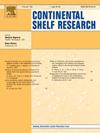Dynamics of low and high density microplastics in the world's largest choked coastal lagoon under contrasting meteoceanographic conditions
IF 2.2
3区 地球科学
Q2 OCEANOGRAPHY
引用次数: 0
Abstract
The contamination by plastic waste in aquatic environments has become a global issue, scientifically reported since 1970. The size and durability of microplastics (MPs, 1 μm > 5 mm) have made these debris widely distributed in aquatic environments. Despite various ongoing initiatives, there is a need to fill gaps in understanding how MPs are transported from their release sources to their final destinations. Therefore, understanding the distribution and dynamics of MPs in coastal areas, such as lagoons and estuaries, which are considered continental sources of MPs to the oceans, is essential to help fill these gaps and propose alternatives for managing what is the environmental problem of the century. In this context, this study aimed to assess the transport patterns of MPs in Patos Lagoon, the largest choked coastal lagoon in the world, considering contrasting meteoceanographic conditions in the system dynamics, such as wind and discharge. Using the hydrodynamic model TELEMAC-3D and the model for plastics particles TrackMPD, simulations were performed using a type of MP polymer (Polypropylene - PP). The simulations of MP transport considered advection, dispersion and the contribution of biofilm in increasing particle density (representing high-density microplastics). The results indicated a gradient of MPs retention from north to south, with higher concentrations of MPs occurring in the northern part of the system. The central region of the lagoon showed a greater tendency for MP export towards the southern region than retention. Meanwhile, the estuary region of Patos Lagoon exhibited a tendency for export of low-density MPs free of biofilm and retention of higher-density MPs, subject to the action of the Plastisphere. Additionally, based on the results obtained from density occurrence maps, it was possible to suggest potential accumulation areas of MPs throughout the lagoon system, reinforcing that the system can act as a sink in specific regions.
在对比气象海洋学条件下,世界上最大的阻塞沿海泻湖中低密度和高密度微塑料的动态
自1970年科学报道以来,水生环境中的塑料垃圾污染已成为一个全球性问题。微塑料(MPs, 1 μm >;(5毫米))使这些碎屑在水生环境中广泛分布。尽管有各种正在进行的举措,但仍需要填补了解MPs如何从其释放源运输到最终目的地的空白。因此,了解沿海地区(如泻湖和河口,被认为是海洋下院议员的大陆来源)下院议员的分布和动态,对于帮助填补这些空白和提出管理本世纪环境问题的替代方案至关重要。在此背景下,本研究旨在评估世界上最大的沿海阻塞泻湖帕托斯泻湖中MPs的运输模式,考虑到系统动力学中的对比气象海洋条件,如风和排放。利用流体力学模型TELEMAC-3D和塑料颗粒模型TrackMPD,使用一种MP聚合物(聚丙烯- PP)进行了模拟。MP运输的模拟考虑了平流、分散和生物膜对增加颗粒密度(代表高密度微塑料)的贡献。结果表明,从北到南,MPs的保留呈梯度,在系统的北部,MPs的浓度较高。环礁湖中部地区向南部地区出口的多聚物多于保留的多聚物。同时,在塑性球的作用下,帕托斯泻湖河口区呈现出无生物膜的低密度MPs输出和高密度MPs保留的趋势。此外,根据密度分布图获得的结果,可以建议整个泻湖系统中MPs的潜在积聚区域,从而加强该系统可以在特定区域充当水槽的作用。
本文章由计算机程序翻译,如有差异,请以英文原文为准。
求助全文
约1分钟内获得全文
求助全文
来源期刊

Continental Shelf Research
地学-海洋学
CiteScore
4.30
自引率
4.30%
发文量
136
审稿时长
6.1 months
期刊介绍:
Continental Shelf Research publishes articles dealing with the biological, chemical, geological and physical oceanography of the shallow marine environment, from coastal and estuarine waters out to the shelf break. The continental shelf is a critical environment within the land-ocean continuum, and many processes, functions and problems in the continental shelf are driven by terrestrial inputs transported through the rivers and estuaries to the coastal and continental shelf areas. Manuscripts that deal with these topics must make a clear link to the continental shelf. Examples of research areas include:
Physical sedimentology and geomorphology
Geochemistry of the coastal ocean (inorganic and organic)
Marine environment and anthropogenic effects
Interaction of physical dynamics with natural and manmade shoreline features
Benthic, phytoplankton and zooplankton ecology
Coastal water and sediment quality, and ecosystem health
Benthic-pelagic coupling (physical and biogeochemical)
Interactions between physical dynamics (waves, currents, mixing, etc.) and biogeochemical cycles
Estuarine, coastal and shelf sea modelling and process studies.
 求助内容:
求助内容: 应助结果提醒方式:
应助结果提醒方式:


